Economics for Managers: Global Warming and Energy Sources
VerifiedAdded on 2020/02/18
|13
|3393
|29
Report
AI Summary
This economics report, prepared for a "Economics for Managers" course, delves into the critical issue of global warming and its economic implications. The report analyzes the necessity of reducing CO2 emissions to mitigate environmental damage and explores the cost-benefit analysis of pollution reduction policies. It examines the impact of global warming on various aspects of the economy, including temperature increases, agricultural productivity, and sea-level rise. The report also discusses the discount function equation (δ = ρ + gη) in the context of intertemporal consumption and the social rate of time preference. Furthermore, it investigates the energy sector in Australia, contrasting the use of renewable and non-renewable sources, with a focus on coal and natural gas, and the shift towards renewable energy sources. The report highlights the challenges and opportunities associated with transitioning to a more sustainable energy mix.
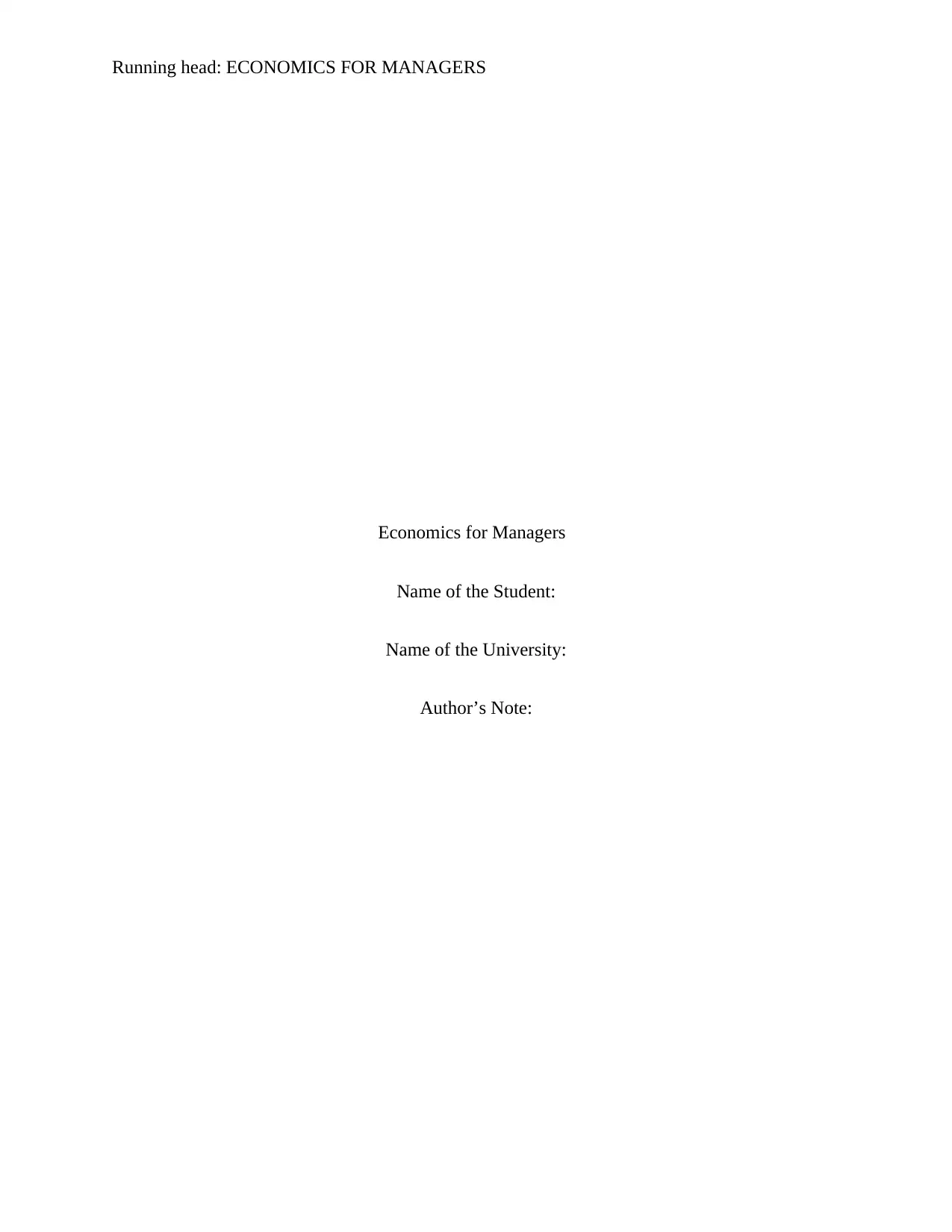
Running head: ECONOMICS FOR MANAGERS
Economics for Managers
Name of the Student:
Name of the University:
Author’s Note:
Economics for Managers
Name of the Student:
Name of the University:
Author’s Note:
Paraphrase This Document
Need a fresh take? Get an instant paraphrase of this document with our AI Paraphraser
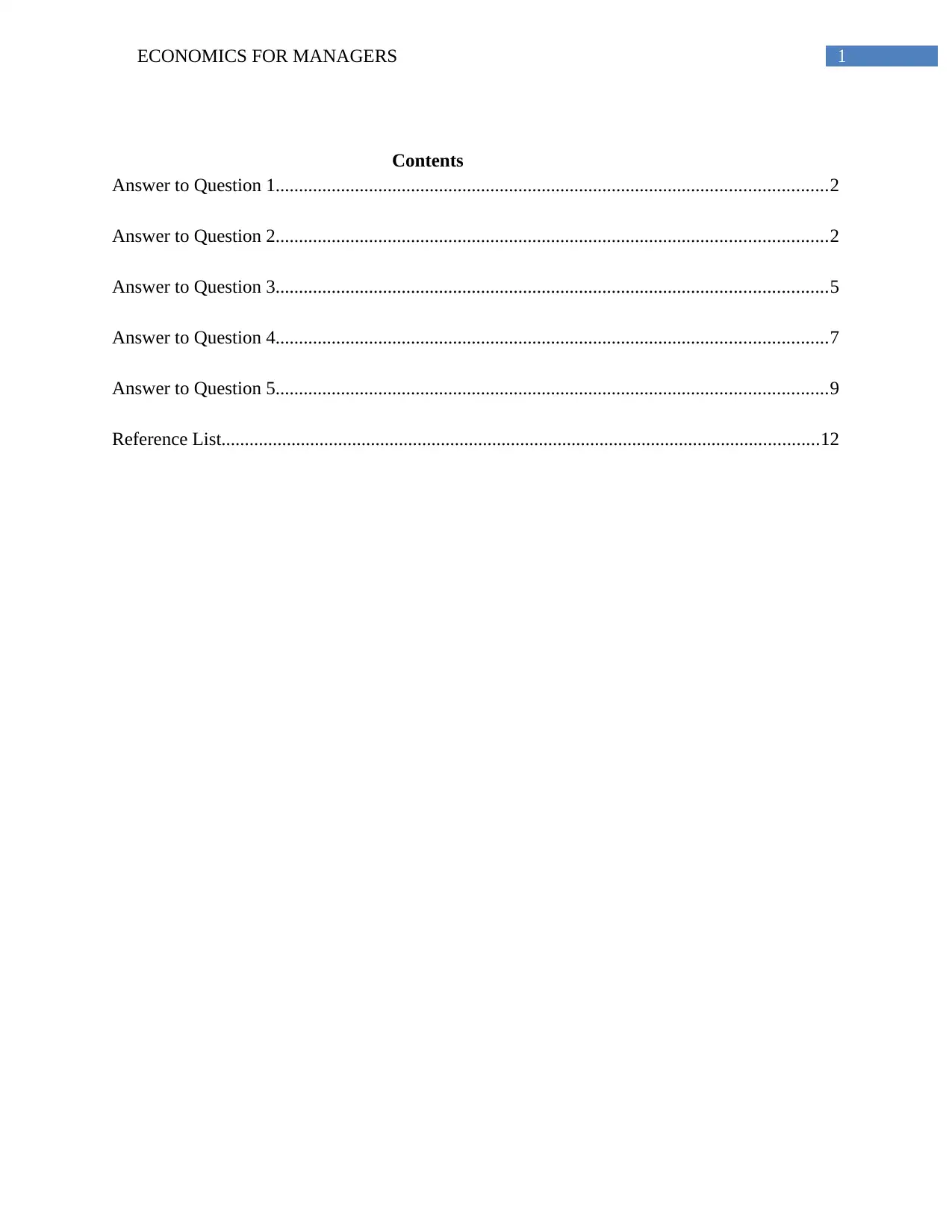
1ECONOMICS FOR MANAGERS
Contents
Answer to Question 1......................................................................................................................2
Answer to Question 2......................................................................................................................2
Answer to Question 3......................................................................................................................5
Answer to Question 4......................................................................................................................7
Answer to Question 5......................................................................................................................9
Reference List................................................................................................................................12
Contents
Answer to Question 1......................................................................................................................2
Answer to Question 2......................................................................................................................2
Answer to Question 3......................................................................................................................5
Answer to Question 4......................................................................................................................7
Answer to Question 5......................................................................................................................9
Reference List................................................................................................................................12
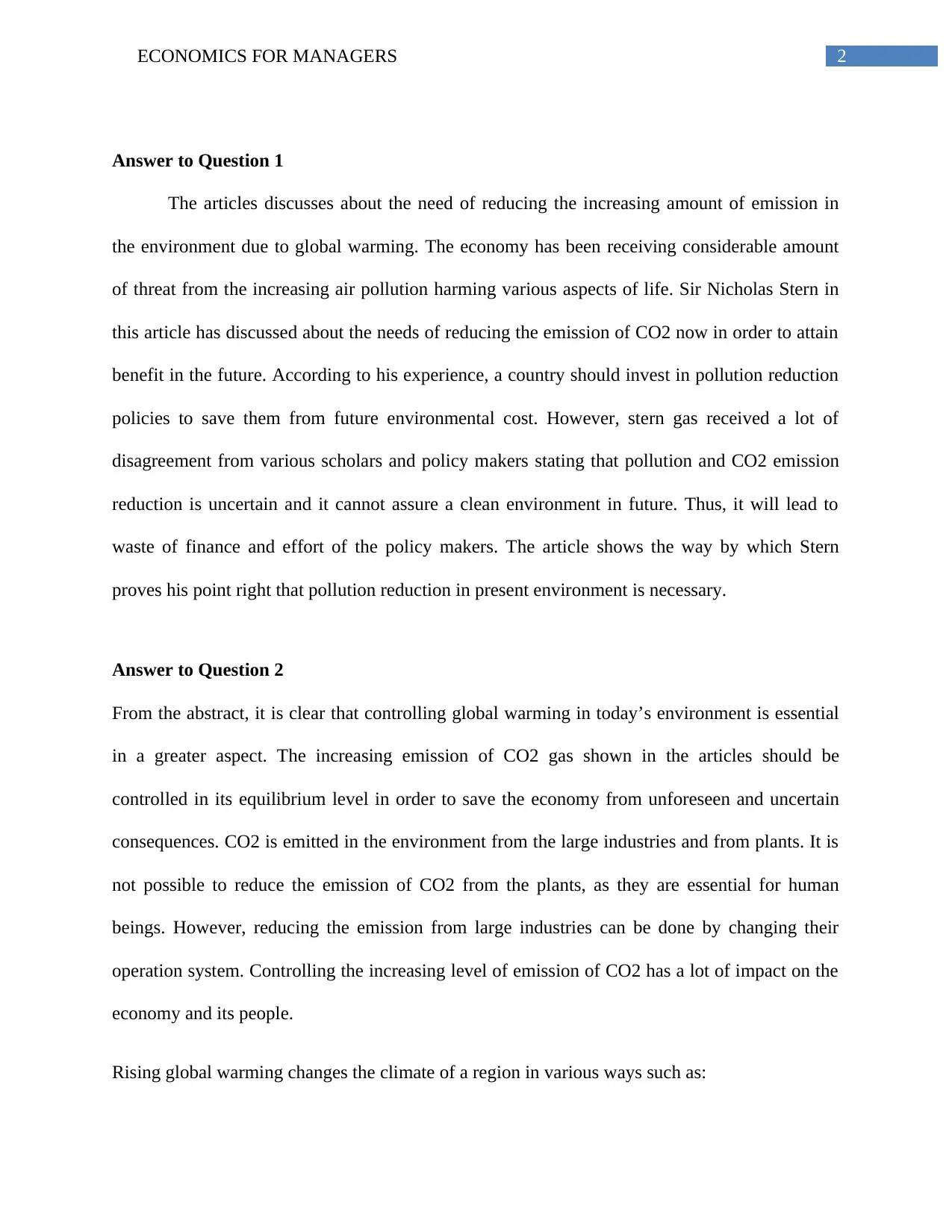
2ECONOMICS FOR MANAGERS
Answer to Question 1
The articles discusses about the need of reducing the increasing amount of emission in
the environment due to global warming. The economy has been receiving considerable amount
of threat from the increasing air pollution harming various aspects of life. Sir Nicholas Stern in
this article has discussed about the needs of reducing the emission of CO2 now in order to attain
benefit in the future. According to his experience, a country should invest in pollution reduction
policies to save them from future environmental cost. However, stern gas received a lot of
disagreement from various scholars and policy makers stating that pollution and CO2 emission
reduction is uncertain and it cannot assure a clean environment in future. Thus, it will lead to
waste of finance and effort of the policy makers. The article shows the way by which Stern
proves his point right that pollution reduction in present environment is necessary.
Answer to Question 2
From the abstract, it is clear that controlling global warming in today’s environment is essential
in a greater aspect. The increasing emission of CO2 gas shown in the articles should be
controlled in its equilibrium level in order to save the economy from unforeseen and uncertain
consequences. CO2 is emitted in the environment from the large industries and from plants. It is
not possible to reduce the emission of CO2 from the plants, as they are essential for human
beings. However, reducing the emission from large industries can be done by changing their
operation system. Controlling the increasing level of emission of CO2 has a lot of impact on the
economy and its people.
Rising global warming changes the climate of a region in various ways such as:
Answer to Question 1
The articles discusses about the need of reducing the increasing amount of emission in
the environment due to global warming. The economy has been receiving considerable amount
of threat from the increasing air pollution harming various aspects of life. Sir Nicholas Stern in
this article has discussed about the needs of reducing the emission of CO2 now in order to attain
benefit in the future. According to his experience, a country should invest in pollution reduction
policies to save them from future environmental cost. However, stern gas received a lot of
disagreement from various scholars and policy makers stating that pollution and CO2 emission
reduction is uncertain and it cannot assure a clean environment in future. Thus, it will lead to
waste of finance and effort of the policy makers. The article shows the way by which Stern
proves his point right that pollution reduction in present environment is necessary.
Answer to Question 2
From the abstract, it is clear that controlling global warming in today’s environment is essential
in a greater aspect. The increasing emission of CO2 gas shown in the articles should be
controlled in its equilibrium level in order to save the economy from unforeseen and uncertain
consequences. CO2 is emitted in the environment from the large industries and from plants. It is
not possible to reduce the emission of CO2 from the plants, as they are essential for human
beings. However, reducing the emission from large industries can be done by changing their
operation system. Controlling the increasing level of emission of CO2 has a lot of impact on the
economy and its people.
Rising global warming changes the climate of a region in various ways such as:
⊘ This is a preview!⊘
Do you want full access?
Subscribe today to unlock all pages.

Trusted by 1+ million students worldwide
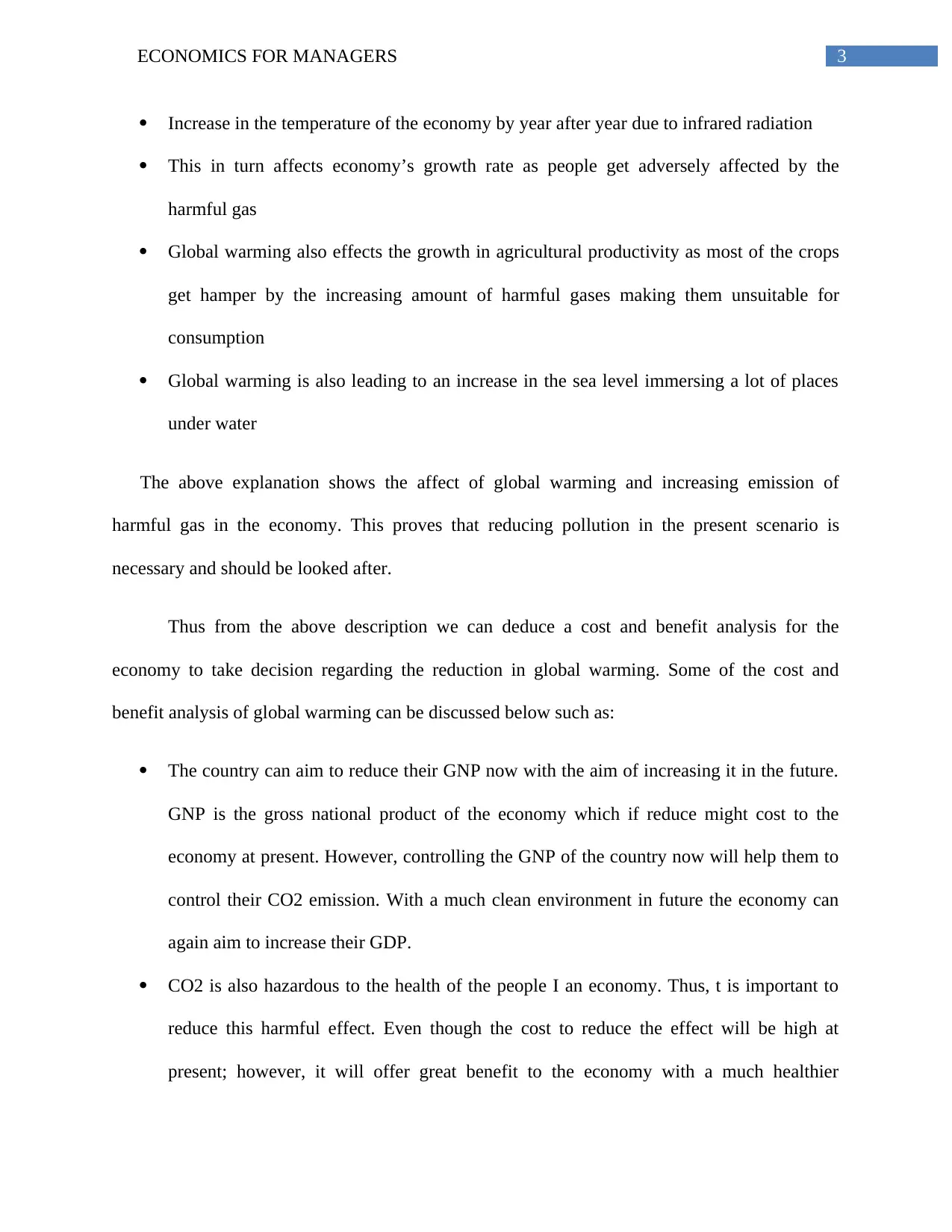
3ECONOMICS FOR MANAGERS
Increase in the temperature of the economy by year after year due to infrared radiation
This in turn affects economy’s growth rate as people get adversely affected by the
harmful gas
Global warming also effects the growth in agricultural productivity as most of the crops
get hamper by the increasing amount of harmful gases making them unsuitable for
consumption
Global warming is also leading to an increase in the sea level immersing a lot of places
under water
The above explanation shows the affect of global warming and increasing emission of
harmful gas in the economy. This proves that reducing pollution in the present scenario is
necessary and should be looked after.
Thus from the above description we can deduce a cost and benefit analysis for the
economy to take decision regarding the reduction in global warming. Some of the cost and
benefit analysis of global warming can be discussed below such as:
The country can aim to reduce their GNP now with the aim of increasing it in the future.
GNP is the gross national product of the economy which if reduce might cost to the
economy at present. However, controlling the GNP of the country now will help them to
control their CO2 emission. With a much clean environment in future the economy can
again aim to increase their GDP.
CO2 is also hazardous to the health of the people I an economy. Thus, t is important to
reduce this harmful effect. Even though the cost to reduce the effect will be high at
present; however, it will offer great benefit to the economy with a much healthier
Increase in the temperature of the economy by year after year due to infrared radiation
This in turn affects economy’s growth rate as people get adversely affected by the
harmful gas
Global warming also effects the growth in agricultural productivity as most of the crops
get hamper by the increasing amount of harmful gases making them unsuitable for
consumption
Global warming is also leading to an increase in the sea level immersing a lot of places
under water
The above explanation shows the affect of global warming and increasing emission of
harmful gas in the economy. This proves that reducing pollution in the present scenario is
necessary and should be looked after.
Thus from the above description we can deduce a cost and benefit analysis for the
economy to take decision regarding the reduction in global warming. Some of the cost and
benefit analysis of global warming can be discussed below such as:
The country can aim to reduce their GNP now with the aim of increasing it in the future.
GNP is the gross national product of the economy which if reduce might cost to the
economy at present. However, controlling the GNP of the country now will help them to
control their CO2 emission. With a much clean environment in future the economy can
again aim to increase their GDP.
CO2 is also hazardous to the health of the people I an economy. Thus, t is important to
reduce this harmful effect. Even though the cost to reduce the effect will be high at
present; however, it will offer great benefit to the economy with a much healthier
Paraphrase This Document
Need a fresh take? Get an instant paraphrase of this document with our AI Paraphraser
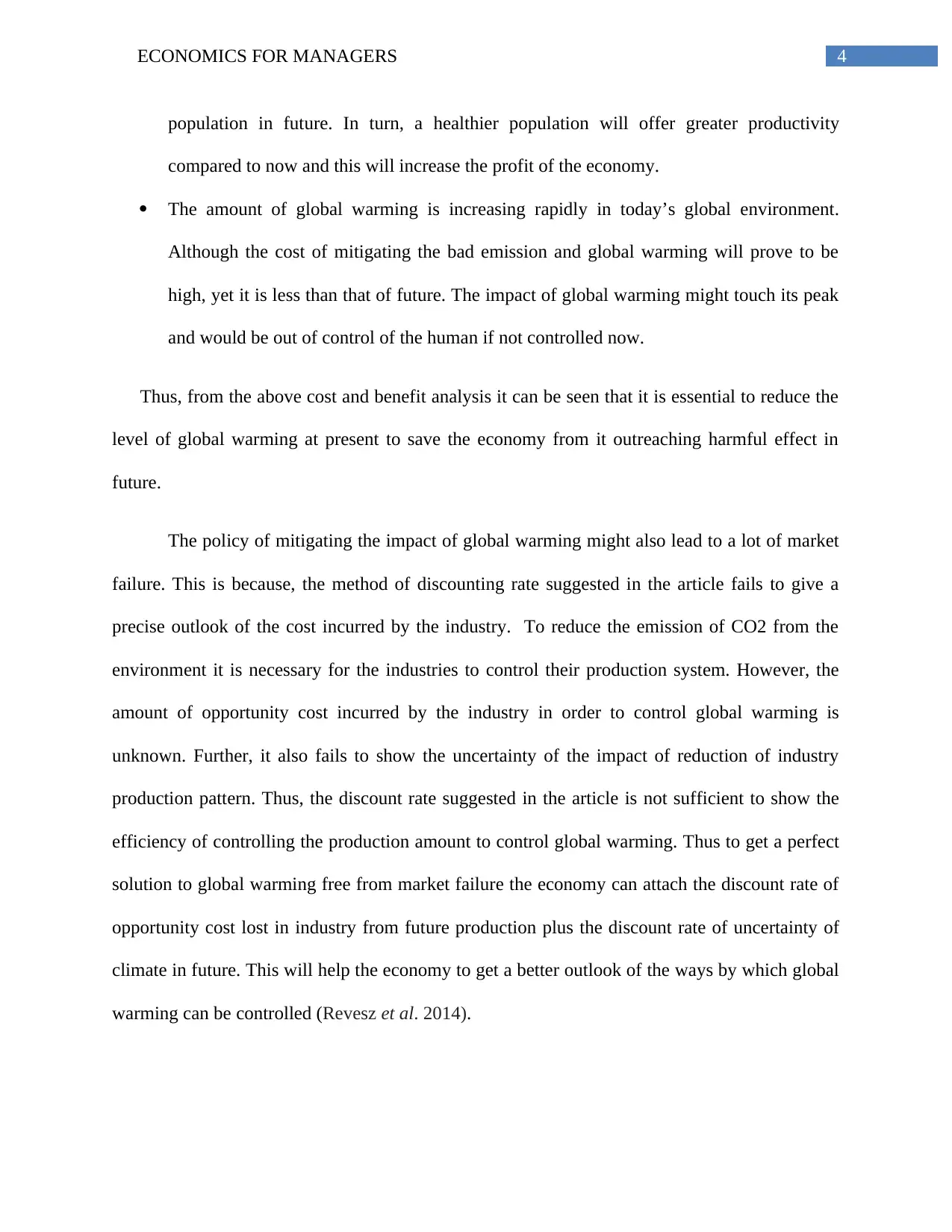
4ECONOMICS FOR MANAGERS
population in future. In turn, a healthier population will offer greater productivity
compared to now and this will increase the profit of the economy.
The amount of global warming is increasing rapidly in today’s global environment.
Although the cost of mitigating the bad emission and global warming will prove to be
high, yet it is less than that of future. The impact of global warming might touch its peak
and would be out of control of the human if not controlled now.
Thus, from the above cost and benefit analysis it can be seen that it is essential to reduce the
level of global warming at present to save the economy from it outreaching harmful effect in
future.
The policy of mitigating the impact of global warming might also lead to a lot of market
failure. This is because, the method of discounting rate suggested in the article fails to give a
precise outlook of the cost incurred by the industry. To reduce the emission of CO2 from the
environment it is necessary for the industries to control their production system. However, the
amount of opportunity cost incurred by the industry in order to control global warming is
unknown. Further, it also fails to show the uncertainty of the impact of reduction of industry
production pattern. Thus, the discount rate suggested in the article is not sufficient to show the
efficiency of controlling the production amount to control global warming. Thus to get a perfect
solution to global warming free from market failure the economy can attach the discount rate of
opportunity cost lost in industry from future production plus the discount rate of uncertainty of
climate in future. This will help the economy to get a better outlook of the ways by which global
warming can be controlled (Revesz et al. 2014).
population in future. In turn, a healthier population will offer greater productivity
compared to now and this will increase the profit of the economy.
The amount of global warming is increasing rapidly in today’s global environment.
Although the cost of mitigating the bad emission and global warming will prove to be
high, yet it is less than that of future. The impact of global warming might touch its peak
and would be out of control of the human if not controlled now.
Thus, from the above cost and benefit analysis it can be seen that it is essential to reduce the
level of global warming at present to save the economy from it outreaching harmful effect in
future.
The policy of mitigating the impact of global warming might also lead to a lot of market
failure. This is because, the method of discounting rate suggested in the article fails to give a
precise outlook of the cost incurred by the industry. To reduce the emission of CO2 from the
environment it is necessary for the industries to control their production system. However, the
amount of opportunity cost incurred by the industry in order to control global warming is
unknown. Further, it also fails to show the uncertainty of the impact of reduction of industry
production pattern. Thus, the discount rate suggested in the article is not sufficient to show the
efficiency of controlling the production amount to control global warming. Thus to get a perfect
solution to global warming free from market failure the economy can attach the discount rate of
opportunity cost lost in industry from future production plus the discount rate of uncertainty of
climate in future. This will help the economy to get a better outlook of the ways by which global
warming can be controlled (Revesz et al. 2014).
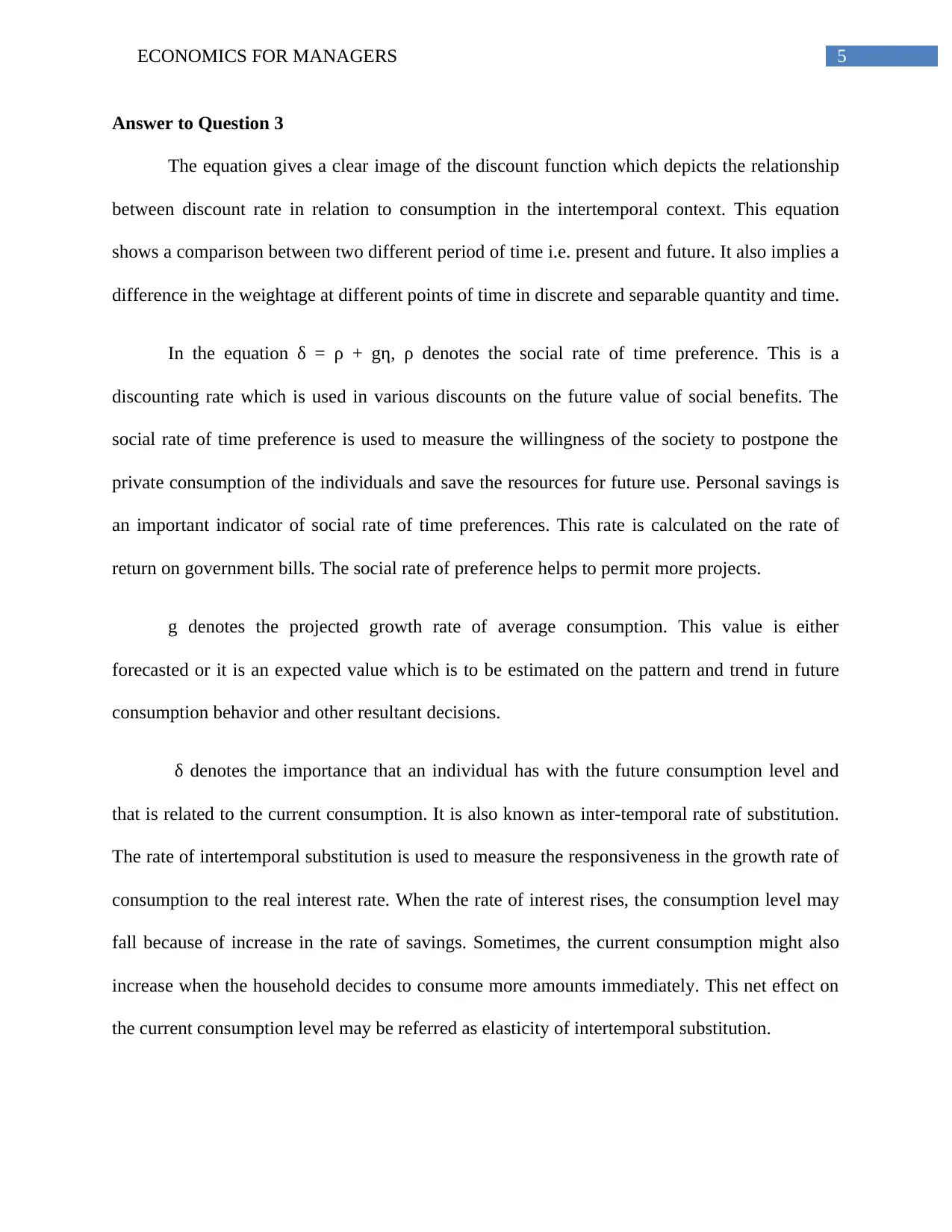
5ECONOMICS FOR MANAGERS
Answer to Question 3
The equation gives a clear image of the discount function which depicts the relationship
between discount rate in relation to consumption in the intertemporal context. This equation
shows a comparison between two different period of time i.e. present and future. It also implies a
difference in the weightage at different points of time in discrete and separable quantity and time.
In the equation δ = ρ + gη, ρ denotes the social rate of time preference. This is a
discounting rate which is used in various discounts on the future value of social benefits. The
social rate of time preference is used to measure the willingness of the society to postpone the
private consumption of the individuals and save the resources for future use. Personal savings is
an important indicator of social rate of time preferences. This rate is calculated on the rate of
return on government bills. The social rate of preference helps to permit more projects.
g denotes the projected growth rate of average consumption. This value is either
forecasted or it is an expected value which is to be estimated on the pattern and trend in future
consumption behavior and other resultant decisions.
δ denotes the importance that an individual has with the future consumption level and
that is related to the current consumption. It is also known as inter-temporal rate of substitution.
The rate of intertemporal substitution is used to measure the responsiveness in the growth rate of
consumption to the real interest rate. When the rate of interest rises, the consumption level may
fall because of increase in the rate of savings. Sometimes, the current consumption might also
increase when the household decides to consume more amounts immediately. This net effect on
the current consumption level may be referred as elasticity of intertemporal substitution.
Answer to Question 3
The equation gives a clear image of the discount function which depicts the relationship
between discount rate in relation to consumption in the intertemporal context. This equation
shows a comparison between two different period of time i.e. present and future. It also implies a
difference in the weightage at different points of time in discrete and separable quantity and time.
In the equation δ = ρ + gη, ρ denotes the social rate of time preference. This is a
discounting rate which is used in various discounts on the future value of social benefits. The
social rate of time preference is used to measure the willingness of the society to postpone the
private consumption of the individuals and save the resources for future use. Personal savings is
an important indicator of social rate of time preferences. This rate is calculated on the rate of
return on government bills. The social rate of preference helps to permit more projects.
g denotes the projected growth rate of average consumption. This value is either
forecasted or it is an expected value which is to be estimated on the pattern and trend in future
consumption behavior and other resultant decisions.
δ denotes the importance that an individual has with the future consumption level and
that is related to the current consumption. It is also known as inter-temporal rate of substitution.
The rate of intertemporal substitution is used to measure the responsiveness in the growth rate of
consumption to the real interest rate. When the rate of interest rises, the consumption level may
fall because of increase in the rate of savings. Sometimes, the current consumption might also
increase when the household decides to consume more amounts immediately. This net effect on
the current consumption level may be referred as elasticity of intertemporal substitution.
⊘ This is a preview!⊘
Do you want full access?
Subscribe today to unlock all pages.

Trusted by 1+ million students worldwide
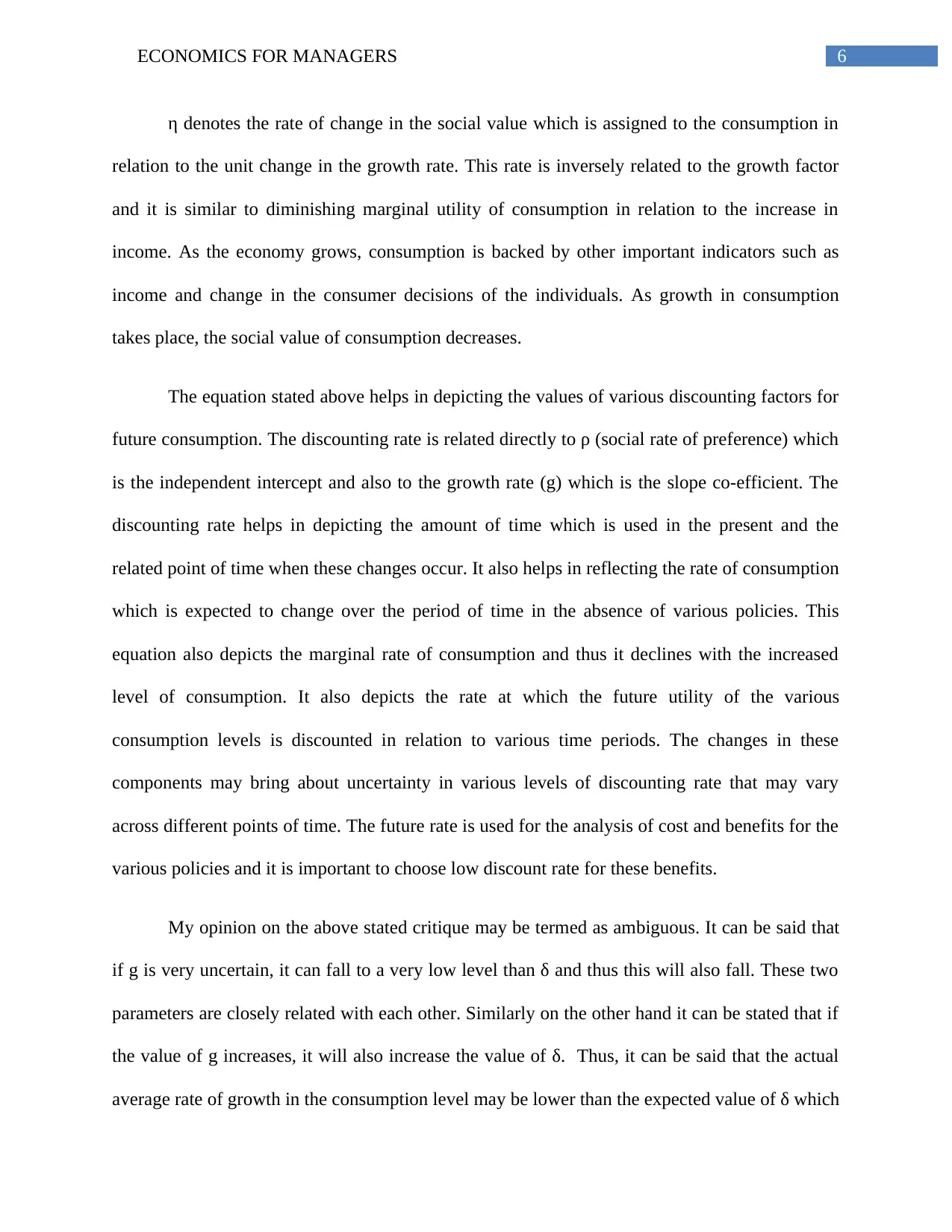
6ECONOMICS FOR MANAGERS
η denotes the rate of change in the social value which is assigned to the consumption in
relation to the unit change in the growth rate. This rate is inversely related to the growth factor
and it is similar to diminishing marginal utility of consumption in relation to the increase in
income. As the economy grows, consumption is backed by other important indicators such as
income and change in the consumer decisions of the individuals. As growth in consumption
takes place, the social value of consumption decreases.
The equation stated above helps in depicting the values of various discounting factors for
future consumption. The discounting rate is related directly to ρ (social rate of preference) which
is the independent intercept and also to the growth rate (g) which is the slope co-efficient. The
discounting rate helps in depicting the amount of time which is used in the present and the
related point of time when these changes occur. It also helps in reflecting the rate of consumption
which is expected to change over the period of time in the absence of various policies. This
equation also depicts the marginal rate of consumption and thus it declines with the increased
level of consumption. It also depicts the rate at which the future utility of the various
consumption levels is discounted in relation to various time periods. The changes in these
components may bring about uncertainty in various levels of discounting rate that may vary
across different points of time. The future rate is used for the analysis of cost and benefits for the
various policies and it is important to choose low discount rate for these benefits.
My opinion on the above stated critique may be termed as ambiguous. It can be said that
if g is very uncertain, it can fall to a very low level than δ and thus this will also fall. These two
parameters are closely related with each other. Similarly on the other hand it can be stated that if
the value of g increases, it will also increase the value of δ. Thus, it can be said that the actual
average rate of growth in the consumption level may be lower than the expected value of δ which
η denotes the rate of change in the social value which is assigned to the consumption in
relation to the unit change in the growth rate. This rate is inversely related to the growth factor
and it is similar to diminishing marginal utility of consumption in relation to the increase in
income. As the economy grows, consumption is backed by other important indicators such as
income and change in the consumer decisions of the individuals. As growth in consumption
takes place, the social value of consumption decreases.
The equation stated above helps in depicting the values of various discounting factors for
future consumption. The discounting rate is related directly to ρ (social rate of preference) which
is the independent intercept and also to the growth rate (g) which is the slope co-efficient. The
discounting rate helps in depicting the amount of time which is used in the present and the
related point of time when these changes occur. It also helps in reflecting the rate of consumption
which is expected to change over the period of time in the absence of various policies. This
equation also depicts the marginal rate of consumption and thus it declines with the increased
level of consumption. It also depicts the rate at which the future utility of the various
consumption levels is discounted in relation to various time periods. The changes in these
components may bring about uncertainty in various levels of discounting rate that may vary
across different points of time. The future rate is used for the analysis of cost and benefits for the
various policies and it is important to choose low discount rate for these benefits.
My opinion on the above stated critique may be termed as ambiguous. It can be said that
if g is very uncertain, it can fall to a very low level than δ and thus this will also fall. These two
parameters are closely related with each other. Similarly on the other hand it can be stated that if
the value of g increases, it will also increase the value of δ. Thus, it can be said that the actual
average rate of growth in the consumption level may be lower than the expected value of δ which
Paraphrase This Document
Need a fresh take? Get an instant paraphrase of this document with our AI Paraphraser
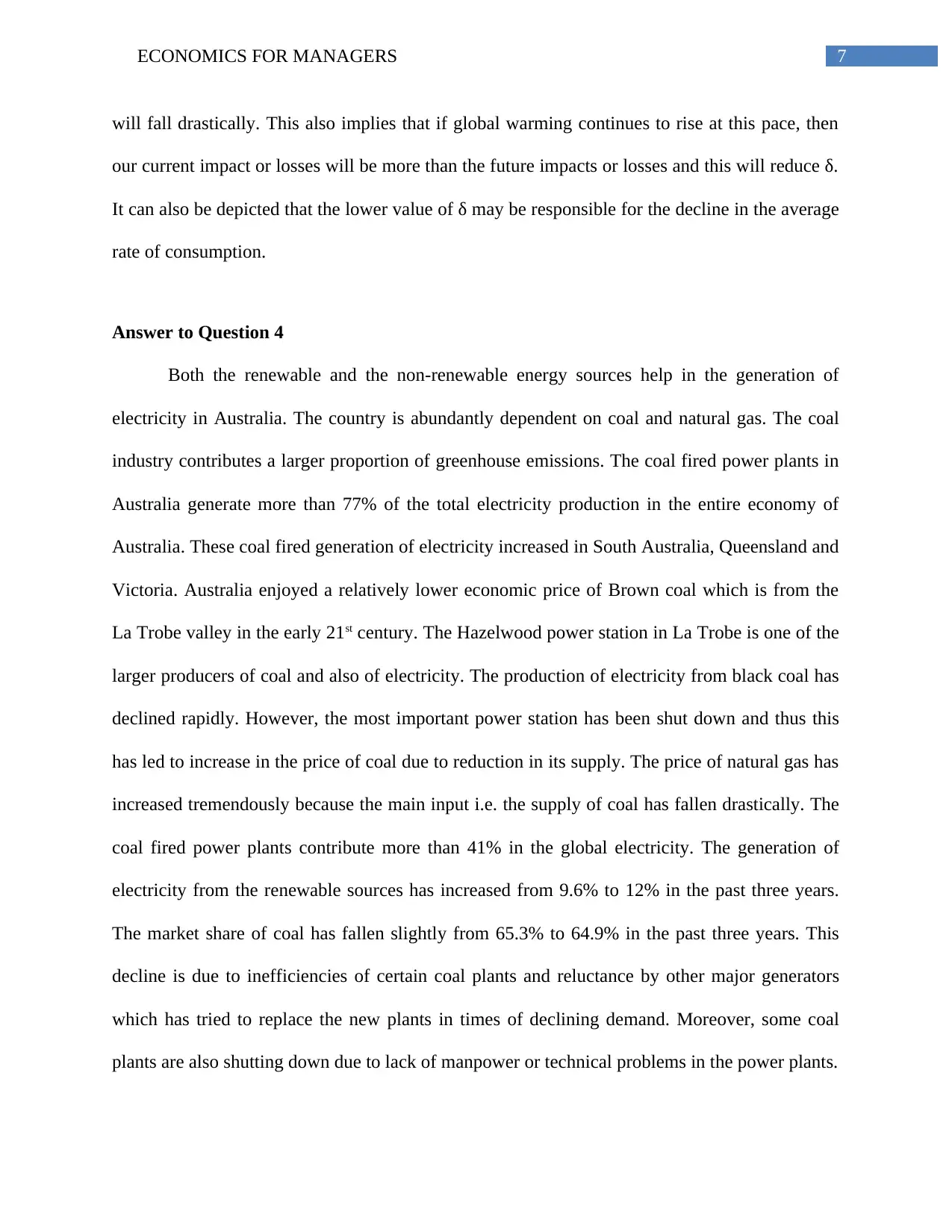
7ECONOMICS FOR MANAGERS
will fall drastically. This also implies that if global warming continues to rise at this pace, then
our current impact or losses will be more than the future impacts or losses and this will reduce δ.
It can also be depicted that the lower value of δ may be responsible for the decline in the average
rate of consumption.
Answer to Question 4
Both the renewable and the non-renewable energy sources help in the generation of
electricity in Australia. The country is abundantly dependent on coal and natural gas. The coal
industry contributes a larger proportion of greenhouse emissions. The coal fired power plants in
Australia generate more than 77% of the total electricity production in the entire economy of
Australia. These coal fired generation of electricity increased in South Australia, Queensland and
Victoria. Australia enjoyed a relatively lower economic price of Brown coal which is from the
La Trobe valley in the early 21st century. The Hazelwood power station in La Trobe is one of the
larger producers of coal and also of electricity. The production of electricity from black coal has
declined rapidly. However, the most important power station has been shut down and thus this
has led to increase in the price of coal due to reduction in its supply. The price of natural gas has
increased tremendously because the main input i.e. the supply of coal has fallen drastically. The
coal fired power plants contribute more than 41% in the global electricity. The generation of
electricity from the renewable sources has increased from 9.6% to 12% in the past three years.
The market share of coal has fallen slightly from 65.3% to 64.9% in the past three years. This
decline is due to inefficiencies of certain coal plants and reluctance by other major generators
which has tried to replace the new plants in times of declining demand. Moreover, some coal
plants are also shutting down due to lack of manpower or technical problems in the power plants.
will fall drastically. This also implies that if global warming continues to rise at this pace, then
our current impact or losses will be more than the future impacts or losses and this will reduce δ.
It can also be depicted that the lower value of δ may be responsible for the decline in the average
rate of consumption.
Answer to Question 4
Both the renewable and the non-renewable energy sources help in the generation of
electricity in Australia. The country is abundantly dependent on coal and natural gas. The coal
industry contributes a larger proportion of greenhouse emissions. The coal fired power plants in
Australia generate more than 77% of the total electricity production in the entire economy of
Australia. These coal fired generation of electricity increased in South Australia, Queensland and
Victoria. Australia enjoyed a relatively lower economic price of Brown coal which is from the
La Trobe valley in the early 21st century. The Hazelwood power station in La Trobe is one of the
larger producers of coal and also of electricity. The production of electricity from black coal has
declined rapidly. However, the most important power station has been shut down and thus this
has led to increase in the price of coal due to reduction in its supply. The price of natural gas has
increased tremendously because the main input i.e. the supply of coal has fallen drastically. The
coal fired power plants contribute more than 41% in the global electricity. The generation of
electricity from the renewable sources has increased from 9.6% to 12% in the past three years.
The market share of coal has fallen slightly from 65.3% to 64.9% in the past three years. This
decline is due to inefficiencies of certain coal plants and reluctance by other major generators
which has tried to replace the new plants in times of declining demand. Moreover, some coal
plants are also shutting down due to lack of manpower or technical problems in the power plants.
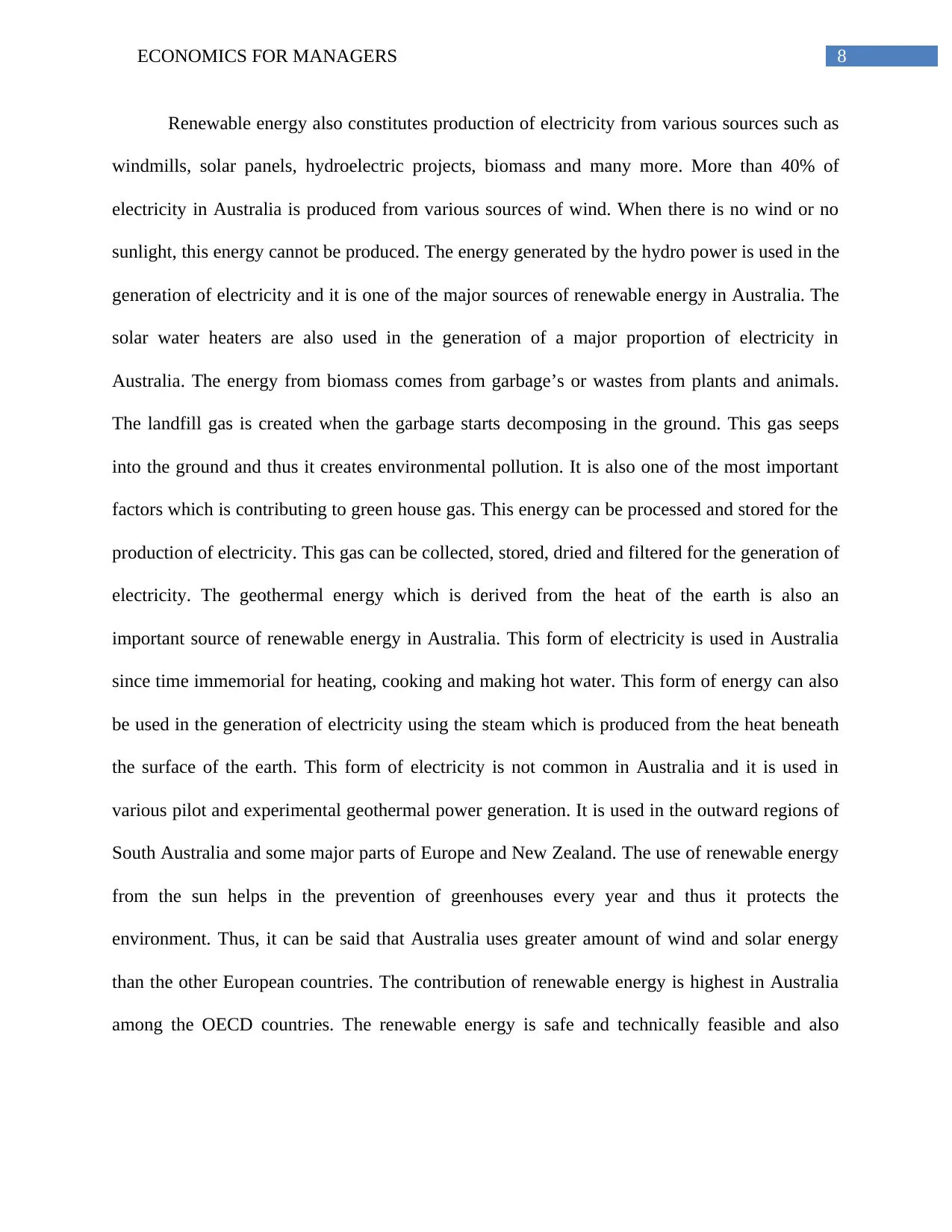
8ECONOMICS FOR MANAGERS
Renewable energy also constitutes production of electricity from various sources such as
windmills, solar panels, hydroelectric projects, biomass and many more. More than 40% of
electricity in Australia is produced from various sources of wind. When there is no wind or no
sunlight, this energy cannot be produced. The energy generated by the hydro power is used in the
generation of electricity and it is one of the major sources of renewable energy in Australia. The
solar water heaters are also used in the generation of a major proportion of electricity in
Australia. The energy from biomass comes from garbage’s or wastes from plants and animals.
The landfill gas is created when the garbage starts decomposing in the ground. This gas seeps
into the ground and thus it creates environmental pollution. It is also one of the most important
factors which is contributing to green house gas. This energy can be processed and stored for the
production of electricity. This gas can be collected, stored, dried and filtered for the generation of
electricity. The geothermal energy which is derived from the heat of the earth is also an
important source of renewable energy in Australia. This form of electricity is used in Australia
since time immemorial for heating, cooking and making hot water. This form of energy can also
be used in the generation of electricity using the steam which is produced from the heat beneath
the surface of the earth. This form of electricity is not common in Australia and it is used in
various pilot and experimental geothermal power generation. It is used in the outward regions of
South Australia and some major parts of Europe and New Zealand. The use of renewable energy
from the sun helps in the prevention of greenhouses every year and thus it protects the
environment. Thus, it can be said that Australia uses greater amount of wind and solar energy
than the other European countries. The contribution of renewable energy is highest in Australia
among the OECD countries. The renewable energy is safe and technically feasible and also
Renewable energy also constitutes production of electricity from various sources such as
windmills, solar panels, hydroelectric projects, biomass and many more. More than 40% of
electricity in Australia is produced from various sources of wind. When there is no wind or no
sunlight, this energy cannot be produced. The energy generated by the hydro power is used in the
generation of electricity and it is one of the major sources of renewable energy in Australia. The
solar water heaters are also used in the generation of a major proportion of electricity in
Australia. The energy from biomass comes from garbage’s or wastes from plants and animals.
The landfill gas is created when the garbage starts decomposing in the ground. This gas seeps
into the ground and thus it creates environmental pollution. It is also one of the most important
factors which is contributing to green house gas. This energy can be processed and stored for the
production of electricity. This gas can be collected, stored, dried and filtered for the generation of
electricity. The geothermal energy which is derived from the heat of the earth is also an
important source of renewable energy in Australia. This form of electricity is used in Australia
since time immemorial for heating, cooking and making hot water. This form of energy can also
be used in the generation of electricity using the steam which is produced from the heat beneath
the surface of the earth. This form of electricity is not common in Australia and it is used in
various pilot and experimental geothermal power generation. It is used in the outward regions of
South Australia and some major parts of Europe and New Zealand. The use of renewable energy
from the sun helps in the prevention of greenhouses every year and thus it protects the
environment. Thus, it can be said that Australia uses greater amount of wind and solar energy
than the other European countries. The contribution of renewable energy is highest in Australia
among the OECD countries. The renewable energy is safe and technically feasible and also
⊘ This is a preview!⊘
Do you want full access?
Subscribe today to unlock all pages.

Trusted by 1+ million students worldwide
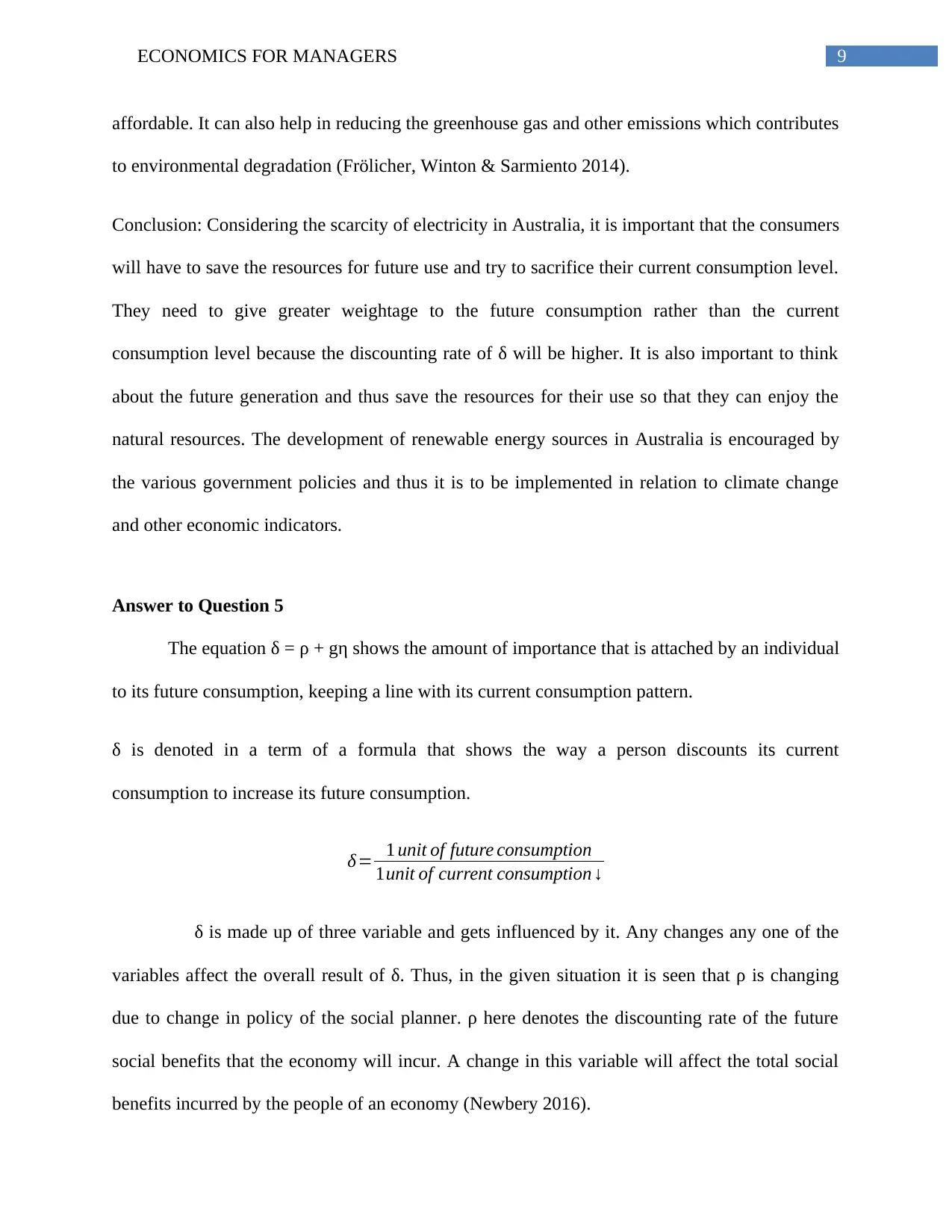
9ECONOMICS FOR MANAGERS
affordable. It can also help in reducing the greenhouse gas and other emissions which contributes
to environmental degradation (Frölicher, Winton & Sarmiento 2014).
Conclusion: Considering the scarcity of electricity in Australia, it is important that the consumers
will have to save the resources for future use and try to sacrifice their current consumption level.
They need to give greater weightage to the future consumption rather than the current
consumption level because the discounting rate of δ will be higher. It is also important to think
about the future generation and thus save the resources for their use so that they can enjoy the
natural resources. The development of renewable energy sources in Australia is encouraged by
the various government policies and thus it is to be implemented in relation to climate change
and other economic indicators.
Answer to Question 5
The equation δ = ρ + gη shows the amount of importance that is attached by an individual
to its future consumption, keeping a line with its current consumption pattern.
δ is denoted in a term of a formula that shows the way a person discounts its current
consumption to increase its future consumption.
δ= 1 unit of future consumption
1unit of current consumption ↓
δ is made up of three variable and gets influenced by it. Any changes any one of the
variables affect the overall result of δ. Thus, in the given situation it is seen that ρ is changing
due to change in policy of the social planner. ρ here denotes the discounting rate of the future
social benefits that the economy will incur. A change in this variable will affect the total social
benefits incurred by the people of an economy (Newbery 2016).
affordable. It can also help in reducing the greenhouse gas and other emissions which contributes
to environmental degradation (Frölicher, Winton & Sarmiento 2014).
Conclusion: Considering the scarcity of electricity in Australia, it is important that the consumers
will have to save the resources for future use and try to sacrifice their current consumption level.
They need to give greater weightage to the future consumption rather than the current
consumption level because the discounting rate of δ will be higher. It is also important to think
about the future generation and thus save the resources for their use so that they can enjoy the
natural resources. The development of renewable energy sources in Australia is encouraged by
the various government policies and thus it is to be implemented in relation to climate change
and other economic indicators.
Answer to Question 5
The equation δ = ρ + gη shows the amount of importance that is attached by an individual
to its future consumption, keeping a line with its current consumption pattern.
δ is denoted in a term of a formula that shows the way a person discounts its current
consumption to increase its future consumption.
δ= 1 unit of future consumption
1unit of current consumption ↓
δ is made up of three variable and gets influenced by it. Any changes any one of the
variables affect the overall result of δ. Thus, in the given situation it is seen that ρ is changing
due to change in policy of the social planner. ρ here denotes the discounting rate of the future
social benefits that the economy will incur. A change in this variable will affect the total social
benefits incurred by the people of an economy (Newbery 2016).
Paraphrase This Document
Need a fresh take? Get an instant paraphrase of this document with our AI Paraphraser
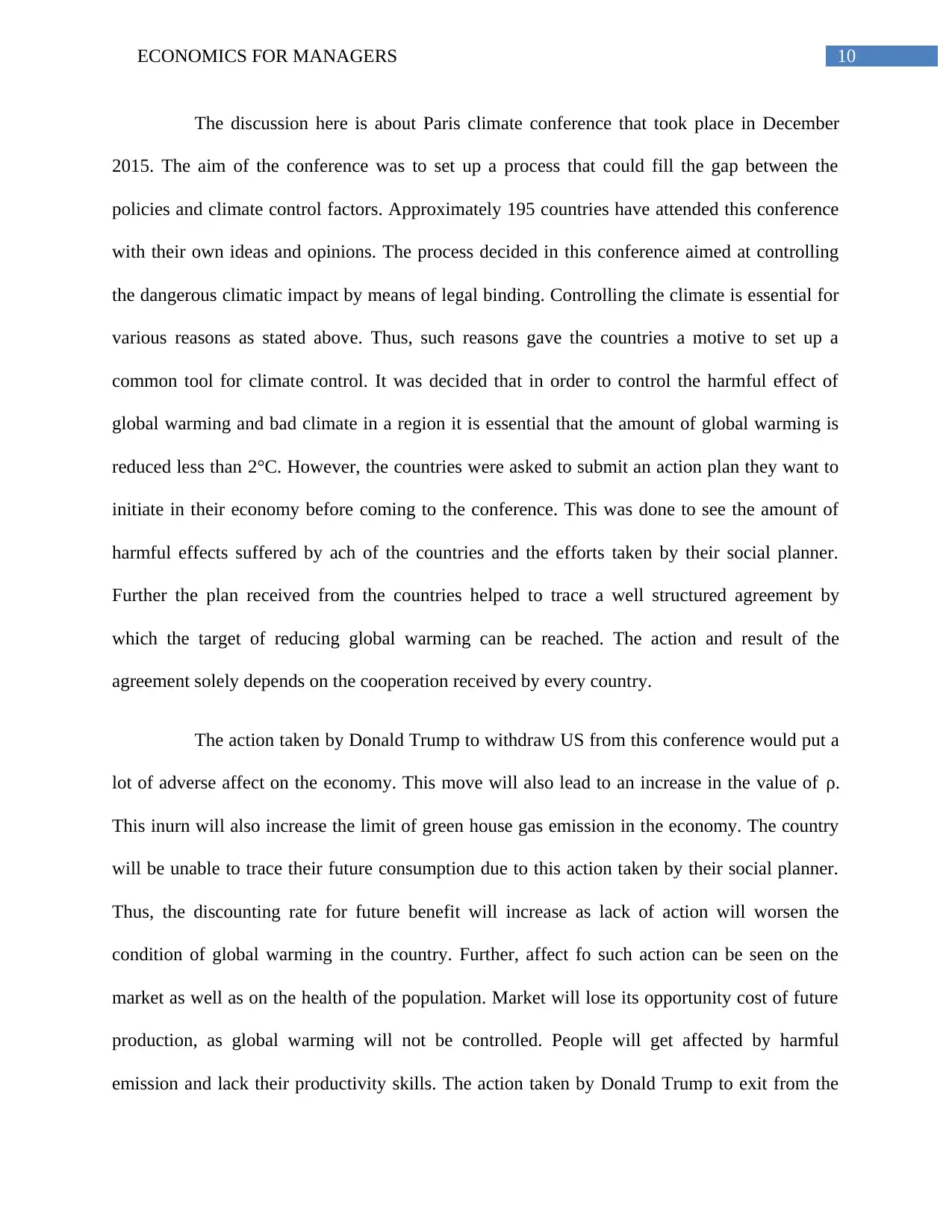
10ECONOMICS FOR MANAGERS
The discussion here is about Paris climate conference that took place in December
2015. The aim of the conference was to set up a process that could fill the gap between the
policies and climate control factors. Approximately 195 countries have attended this conference
with their own ideas and opinions. The process decided in this conference aimed at controlling
the dangerous climatic impact by means of legal binding. Controlling the climate is essential for
various reasons as stated above. Thus, such reasons gave the countries a motive to set up a
common tool for climate control. It was decided that in order to control the harmful effect of
global warming and bad climate in a region it is essential that the amount of global warming is
reduced less than 2°C. However, the countries were asked to submit an action plan they want to
initiate in their economy before coming to the conference. This was done to see the amount of
harmful effects suffered by ach of the countries and the efforts taken by their social planner.
Further the plan received from the countries helped to trace a well structured agreement by
which the target of reducing global warming can be reached. The action and result of the
agreement solely depends on the cooperation received by every country.
The action taken by Donald Trump to withdraw US from this conference would put a
lot of adverse affect on the economy. This move will also lead to an increase in the value of ρ.
This inurn will also increase the limit of green house gas emission in the economy. The country
will be unable to trace their future consumption due to this action taken by their social planner.
Thus, the discounting rate for future benefit will increase as lack of action will worsen the
condition of global warming in the country. Further, affect fo such action can be seen on the
market as well as on the health of the population. Market will lose its opportunity cost of future
production, as global warming will not be controlled. People will get affected by harmful
emission and lack their productivity skills. The action taken by Donald Trump to exit from the
The discussion here is about Paris climate conference that took place in December
2015. The aim of the conference was to set up a process that could fill the gap between the
policies and climate control factors. Approximately 195 countries have attended this conference
with their own ideas and opinions. The process decided in this conference aimed at controlling
the dangerous climatic impact by means of legal binding. Controlling the climate is essential for
various reasons as stated above. Thus, such reasons gave the countries a motive to set up a
common tool for climate control. It was decided that in order to control the harmful effect of
global warming and bad climate in a region it is essential that the amount of global warming is
reduced less than 2°C. However, the countries were asked to submit an action plan they want to
initiate in their economy before coming to the conference. This was done to see the amount of
harmful effects suffered by ach of the countries and the efforts taken by their social planner.
Further the plan received from the countries helped to trace a well structured agreement by
which the target of reducing global warming can be reached. The action and result of the
agreement solely depends on the cooperation received by every country.
The action taken by Donald Trump to withdraw US from this conference would put a
lot of adverse affect on the economy. This move will also lead to an increase in the value of ρ.
This inurn will also increase the limit of green house gas emission in the economy. The country
will be unable to trace their future consumption due to this action taken by their social planner.
Thus, the discounting rate for future benefit will increase as lack of action will worsen the
condition of global warming in the country. Further, affect fo such action can be seen on the
market as well as on the health of the population. Market will lose its opportunity cost of future
production, as global warming will not be controlled. People will get affected by harmful
emission and lack their productivity skills. The action taken by Donald Trump to exit from the
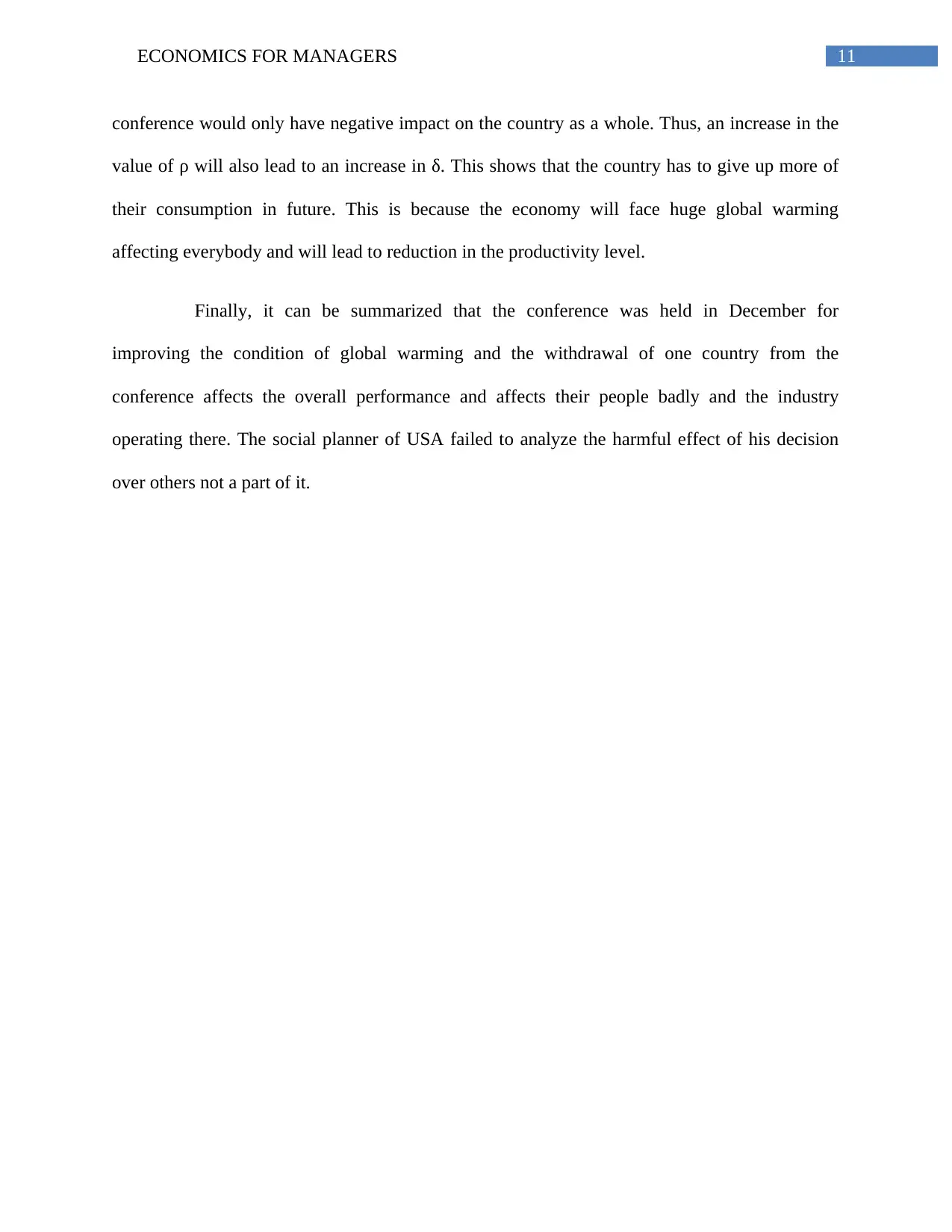
11ECONOMICS FOR MANAGERS
conference would only have negative impact on the country as a whole. Thus, an increase in the
value of ρ will also lead to an increase in δ. This shows that the country has to give up more of
their consumption in future. This is because the economy will face huge global warming
affecting everybody and will lead to reduction in the productivity level.
Finally, it can be summarized that the conference was held in December for
improving the condition of global warming and the withdrawal of one country from the
conference affects the overall performance and affects their people badly and the industry
operating there. The social planner of USA failed to analyze the harmful effect of his decision
over others not a part of it.
conference would only have negative impact on the country as a whole. Thus, an increase in the
value of ρ will also lead to an increase in δ. This shows that the country has to give up more of
their consumption in future. This is because the economy will face huge global warming
affecting everybody and will lead to reduction in the productivity level.
Finally, it can be summarized that the conference was held in December for
improving the condition of global warming and the withdrawal of one country from the
conference affects the overall performance and affects their people badly and the industry
operating there. The social planner of USA failed to analyze the harmful effect of his decision
over others not a part of it.
⊘ This is a preview!⊘
Do you want full access?
Subscribe today to unlock all pages.

Trusted by 1+ million students worldwide
1 out of 13
Related Documents
Your All-in-One AI-Powered Toolkit for Academic Success.
+13062052269
info@desklib.com
Available 24*7 on WhatsApp / Email
![[object Object]](/_next/static/media/star-bottom.7253800d.svg)
Unlock your academic potential
Copyright © 2020–2025 A2Z Services. All Rights Reserved. Developed and managed by ZUCOL.





